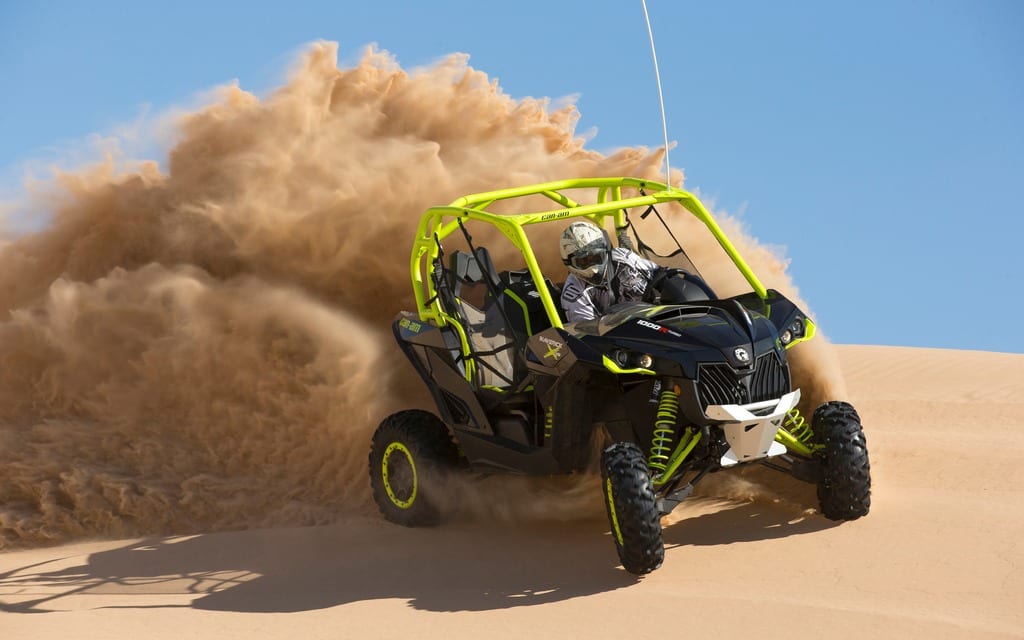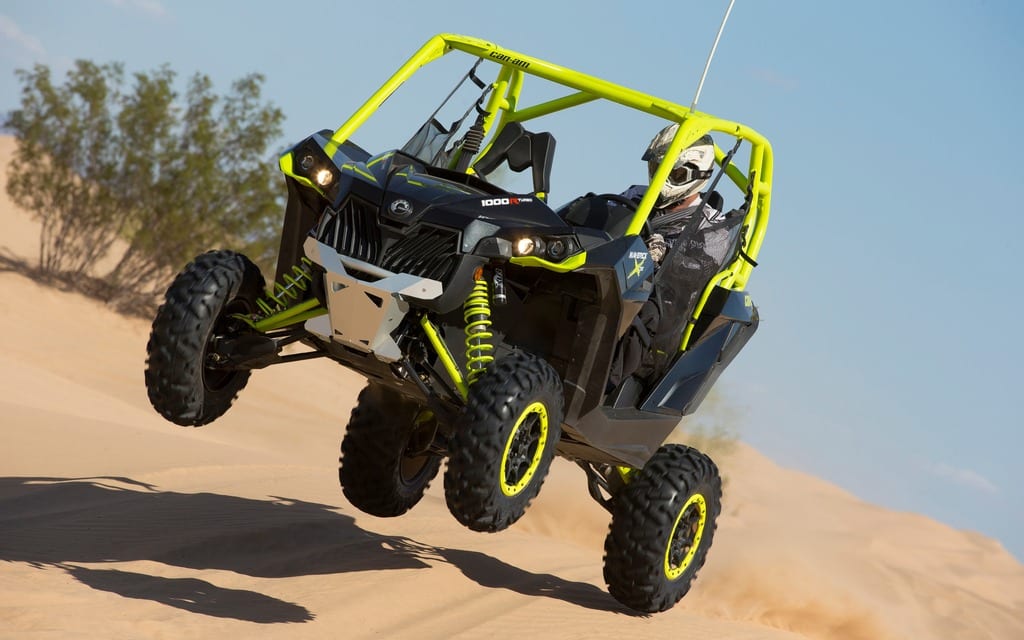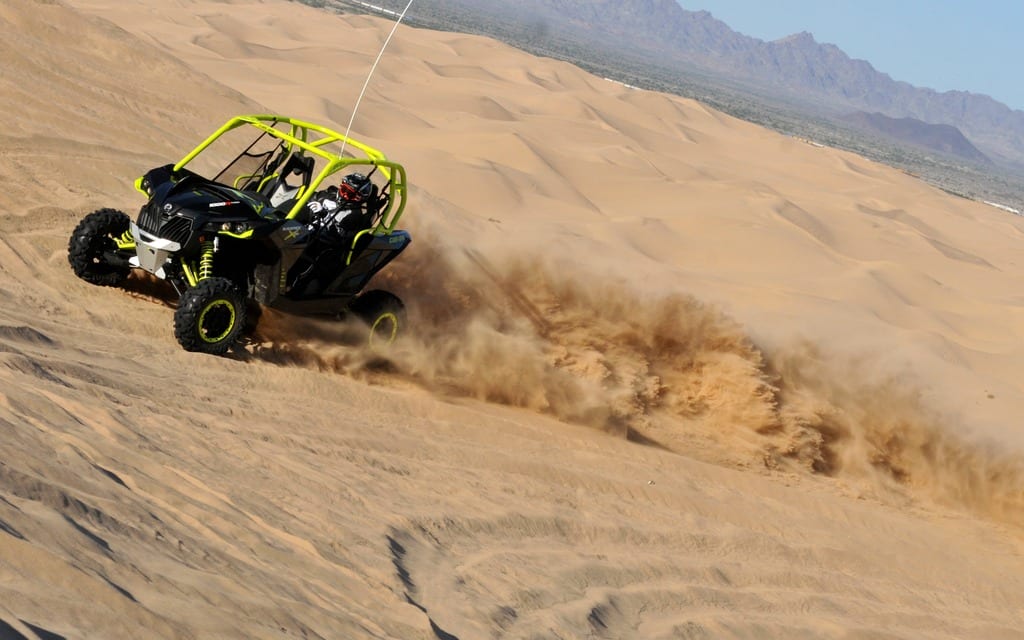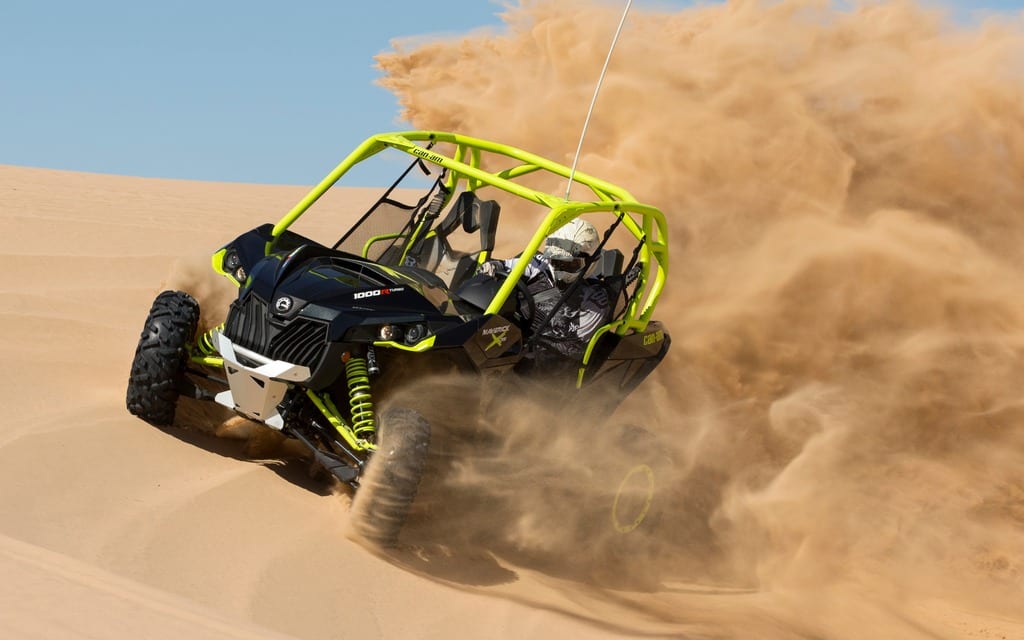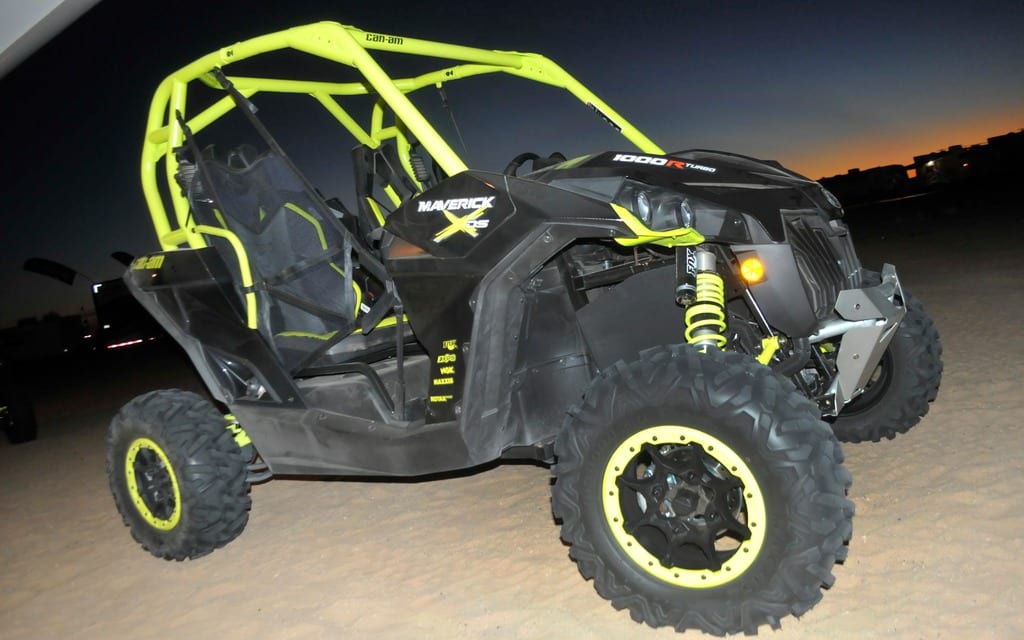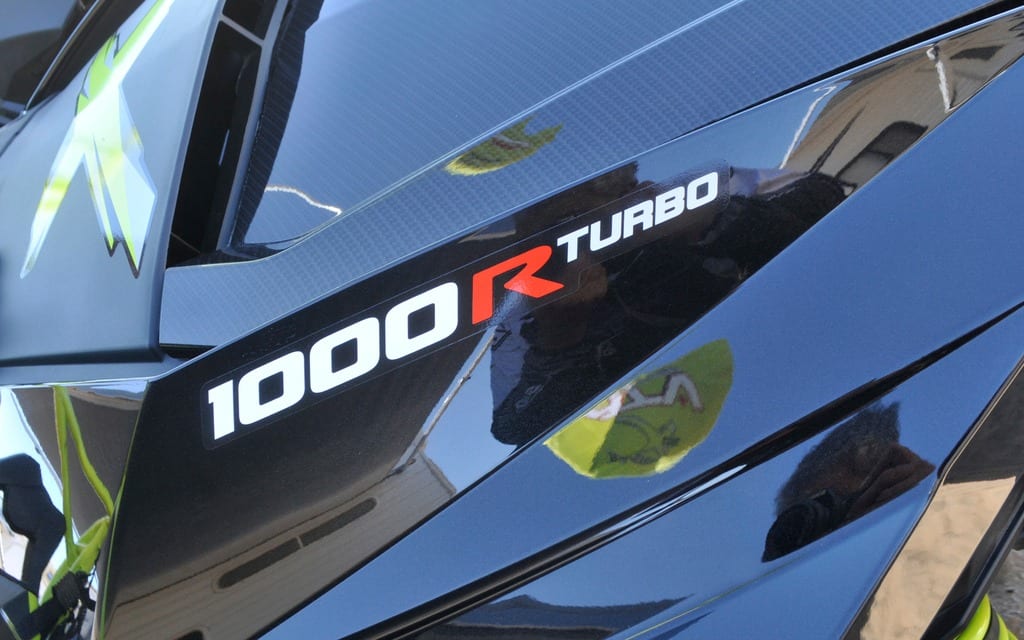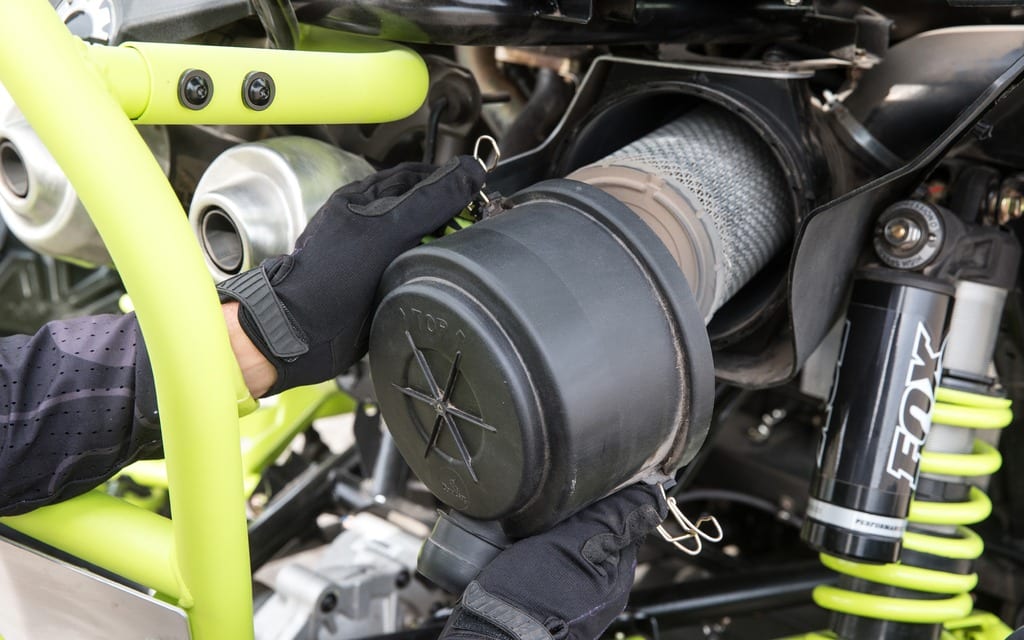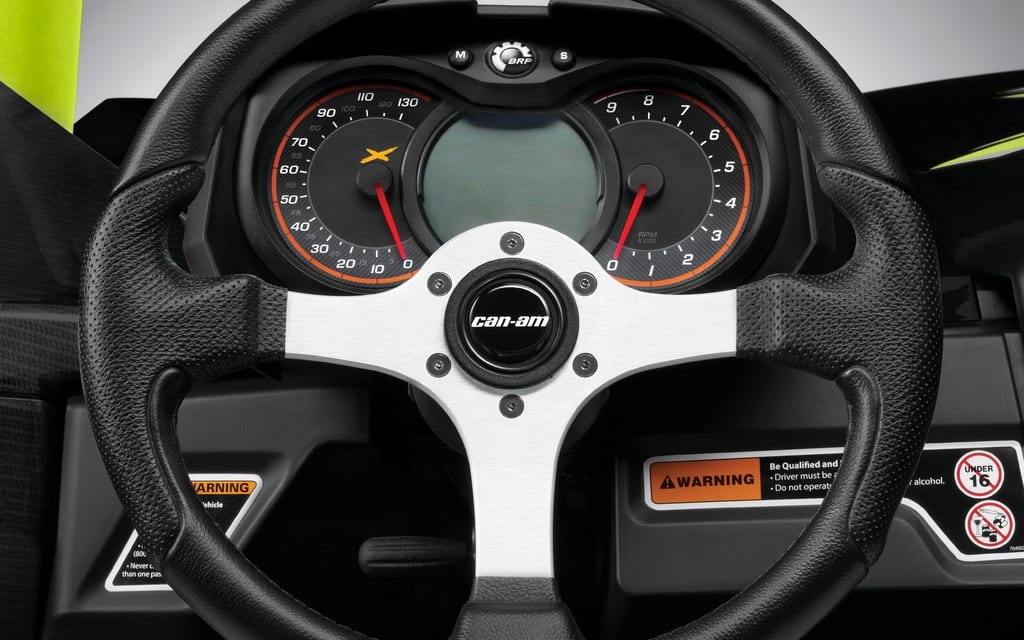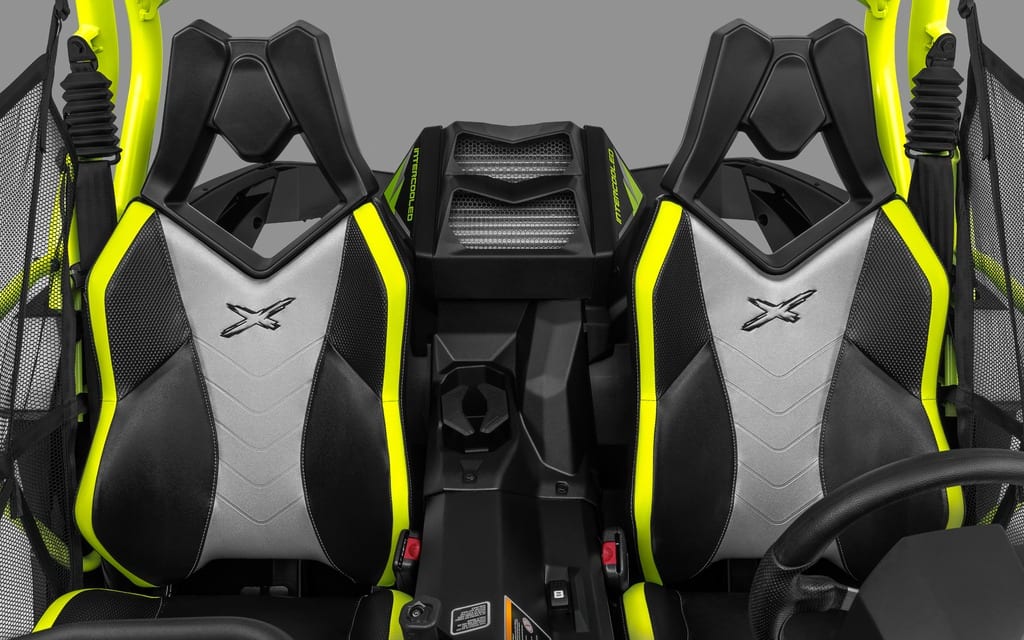The fight for supremacy in the sport Side x Side segment is at a peak, with all three North American manufacturers offering 1000cc class vehicles, offering as much or even more than 100 horsepower. Even so, many off-road aficionados still crave more power and will go to lengths to get even more from their Side x Side going as far as adding a turbo, which not only can be costly, but can also kill a warranty and present some risks to the engine if not done with great care. Can-Am engineers succeeded in seriously boosting the performance of their proven Rotax® 1000R engine, with the industry’s first factory-installed turbocharger option, enabling it to produce an impressive 121 HP.
This isn’t the first time a major manufacturer decides to up the ante, but this move is quite bold and this sizable increase in performance will please the most demanding of off-road fans. Even if this was my first time at Glamis, climbing the highest and steepest sand bowls, I felt totally confident anywhere and everywhere. Trust me when I say it won’t leave any dune conqueror wanting or needing more to climb atop the highest sandy peaks.
My reflex was to first look for that turbo and the way it was placed and working in the vehicle. I quickly spotted the electronically controlled wastegate, automatically adjusting boost pressure for optimal performance in any condition and even maintaining full performance at altitudes up to 5,000-ft. Paired to the turbo is an air-to-air Intercooler with built-in fan to keep cooled air flowing to the engine, something obviously all the more important here in these most demanding conditions. Placement of the Intercooler I found to be very intelligent, since it uses a space that was totally unused and where the most air logically flows through. To keep up with the added pressure in the engine, new low pressure forged pistons were slipped into the cylinders for longer-lasting performance. Finally, the new high capacity injectors ensure a better fuel delivery, providing an optimal air/fuel mixture.
The excitement was as high as it could ever be for an old trail wolf like me who had never been to Glamis sand dunes, a sort of off-road vehicle paradise in California. Popular to a point where every rider in the world has at least heard about the vast playground that can attract hundreds of thousands of riders from anywhere and everywhere, over a weekend. This desert spans 700 square kilometers east of San Diego and that day we had the whole place all to ourselves. Halloween announces the official start of the dune season; since temperatures only start to be clement enough around that time of year and that was the same the following weekend.
The dunes are located west of the Chocolate Mountains in Imperial County, and are crossed by Interstate Route 8 and State Route 78, which passes through the old train stop of Glamis at the eastern edge of the dune field. The north-western end is located at 33°8′53″N 115°19′29″W about 11 mi (18 km) east of Calipatria, California, and the south-eastern end is located at 32°41′4″N 114°46′7″W near Los Algodones in Mexico about 6 miles west of Yuma, Arizona.
The name “Algodones Dunes” refers to the entire geographic feature, while the administrative designation for that portion managed by the Bureau of Land Management is the Imperial Sand Dunes Recreation Area (sometimes called the Glamis Dunes). The most popular theory holds that the Imperial Sand Dunes were formed from windblown beach sands of Lake Cahuilla. The prevailing westerly and northwesterly winds carried the sand eastward from the old lakeshore to their present location. This process continues today. Prevailing winds cause the dunes to migrate southeast at the rate of approximately one foot per year. Backdrop for major Hollywood movies, the Algodones were once part of an even greater dune system that now resides primarily in the Mexican state of Sonora, with a few extensions also in southwestern Arizona, especially in the vicinity of Yuma.
Of course adding a turbo sounds like a simple enough task, but a lot of things needed to be done to the vehicle in order to accept all this extra power and manage it well. All of the groundbreaking innovations of the Can-Am Maverick needed optimizing to deliver this most powerful Side-by-Side vehicle in a solid package. The Continuously Variable Transmission (CVT) with Zylon-reinforced belt showcases a completely redesigned driven pulley with a new Quick Response System (QRS) and an improved drive pulley that allows better power transfer and a faster engagement time. Suspension units also needed to be upgraded of course, taking in consideration the 30-lbs.?the new turbo adds, but more importantly, the fact that the whole vehicle will obviously be exposed to more violent impacts over obstacles. The shocks are beefier, exclusive FOX 2.5 PODIUM RC2 HPG Piggyback shocks, with dual speed compression, rebound and preload adjustments. The rear shocks feature bottom-out control and spring crossover. A redesign of the Torsional Trailing A-arms rear suspension (TTA) was done to climb the travel up 2 inches to 16 in. (40.6 cm) and up front the geometry was also tinkered with, to get an extra inch compared to a base Maverick from the Double A-arm setup.
Riding at Glamis, as well as any other sand dunes, presents a constant need to check the terrain carefully before you start up or down any hill. One should never climb or descend hills with excessively slippery or loose surfaces, yet this machine seemed to draw me towards some of these types of challenges; its capacities being obviously very high. It only took a few crossed sand banks to realize how this ride was safe to push in performance, intelligently.
If you read your owners manual it will tell you never go over the top of any hill at high speed but that all seems so far from reality when you are actually driving this machine with that turbo whizzing in your ear at every play on the intelligent throttle. Whoops seemingly disappear if you can muster the courage to pass the point where it goes into an intense front to back wobble, to where you’re simply grazing the top of every bump and semi-flying over the desert terrain. This is troubling to me as I should stick to the usual don’t do this and don’t do that type of speech but that just wouldn’t be fair to you, the buyer ready to fork out close to $3000 extra bucks for the turbo equipped X-ds. Yes, you can get the X-ds and all its upgrades without the turbo at an MSRP of $21,999. Truth is that machine feels exactly built for the purpose of racing over rough terrain. And so like any devoted test driver would, I did. I couldn’t help but try and find a spot where we could catch a little bit of air, I could almost hear the Fox suspension units asking me to challenge them at least a little bit more. I soon realized that they are just as an exciting part of this vehicle as the turbo. The awesome aggressive-looking overall shape of this desert conquering gem, certainly wasn’t helping me in trying to keep my tires from leaving the ground. I mean look at this thing! It’s just asking for it right? Well the best I can do to play my honest and constructive part in this crazy game, where racing grade performance meets normal everyday drivers, is to share true to life information gathered from true to life experiences with this vehicle and a few others like it. Yes, as you might have noticed from some of our photos in Glamis, we took flight. Not your average little stunt, pretty crazy stuff actually. Even if we try to be politically correct and tell people not to jump, people out there are actually jumping anyways. Many of these people sometimes have no clue about the precise and crucial rules to respect in order to perform such a manoeuvre safely. If it’s your first time, you should ask a buddy who has done it before to first jump with you onboard as a passenger. If he is a good teacher, he will first roll or maybe even stop on the chosen ramp and mention the importance of its length, which absolutely needs to be longer than the vehicle. He will also need to check the tip of the ramp for smoothness. It’s also important to check that it’s equal on both sides. A minor difference in height on both sides will have a huge effect on the angle reached upon landing. Landing at an angle means one or two suspension units will be subjected to a lot stronger forces. Then there is the subject of traction of the tires and how the throttle is played. Whatever you do don’t ever let off the pedal during launch. Not even a fraction of a second before the rear wheels lose contact with the ground.
Ideally you would still have some torque and power left while on the ramp, to give the front of the vehicle an upward push with a full press of the pedal. Another important rule of thumb is to be coming in at moderate speed and accelerating throughout the manoeuvre. What you are constantly fighting is a natural tendency for any type of vehicle to roll forward. There is always that same factor to consider: the fraction of a second when the front is airborne and the rear wheels are still in contact with the ground and the suspension is pushing up on the rear. What you’re doing when you’re staying on the throttle is keeping that suspension from rebounding and being compressed before the vehicle is completely off the ground. The very worst thing you can do is jump your first attempt alone, panic at the end of the ramp let off the throttle, the vehicle will then tip forward and you could front flip or land too hard on the front, which will whip the back end down violently, maybe bottoming out the rear suspension and maybe affecting your back with too much leftover force to absorb. So those who are already familiar with the physics of jumping will appreciate how practical the extra 20 hp can be at the top of a ramp and in the air for angle control. In other words: our Maverick X-ds was a fabulous jumper and a joy to land in. So predictable and controllable throughout the whole sand experience, that I was pushing the vehicle to its maximum almost constantly and it felt easy and smooth like a Sunday drive. Trust me when I say that this was a weekday and I was getting busy!
In regards to the interior of the 2015 Can-Am Maverick X DS Turbo, it is no different than other Maverick models, most of the controls are exactly the same. The seats have little bit of color added to them like any of the other specialty Mavericks and offer the same excellent comfort. Without a doubt, these are the most comfortable seats in the segment. The tri-mode DPS features three selectable levels of steering assistance and just like on their quads I tried all of them and ended up liking the minimum mode a lot more. To me this power steering system remains by far the best also, for taking in consideration that not all drivers have the same tastes or needs when it comes to steering assist in an off-road setting. The quick-ratio made the control of this missile even more fun and precise. The most important technical aspect of this vehicle that will need to pay attention to after all the usual maintenance is your suspension adjustments. It would be a shame not to take full advantage of these, to experience this vehicle fully. These are very high-quality units and offer lots of possibilities for you to dial them in precisely according to the needs of each moment. They were all set in the middle like from factory and for our extreme behaviour, which you should not copy but feel free to study and be inspired by, we needed a serious climb on the high-speed compression and ended up 3 clicks away from the top setting, where it didn’t bottom out on even the worst of landings with the front hitting first and rear- end being whipped. We ended up dropping the rebound a little and set back a few clicks on the low speed compression for a well-balanced mix that lets us hit some decent air, while staying able to go through the never-ending whoops on the stretch back to camp alongside the road, at a much faster pace than on day one.
The large Donaldson air box, positioned close to the engine for maximum airflow, makes checking and maintaining the air filter a piece of cake. Popping out the back next to your sweet-sounding dual exhaust, the cylindrical air filter housing does get quite a beating since that is one of the spots where huge amounts of sand and dust get thrown around constantly. I personally think they should have mounted it somewhere high near the intercooler or anywhere in the rear cargo box to significantly reduce the chances of dust infiltrating. They put a large easy to remove rubber cap on a large drain near the rear tip of the housing, which I unplugged a few times a day and a few tablespoons of sand would come out. I strongly suggest you do the same thing after every dusty ride.
When we talk about these kinds of specialized Side x Side models, we have to consider to higher price tag and when you fall into the $20,000 and up category, I think it becomes important to mention B.E.S.T. Signing up for BRP Extended Service Terms (B.E.S.T.) provides the added peace of mind that comes with knowing your vehicle is covered and will be serviced by BRP-certified technicians and they will use only genuine BRP parts for your repairs. B.E.S.T. offers 6-,12-,18-,24-, 30- or 36-month coverage beyond the manufacturer’s warranty on most BRP vehicles, kicking in the second your vehicle’s limited warranty expires. You’re always covered, whether you’re on the trail or on the water, B.E.S.T. repairs can be done through any authorized BRP dealer in North America. B.E.S.T. transfers ownership whenever your vehicle changes hands, at no cost to either the buyer or seller. The B.E.S.T. protection plan is an unlimited mileage protection, so if like us you like to play on an almost daily basis, we strongly suggest you buy a plan.
The most powerful two-seater sport side-by-side in the industry is now a Can-Am and the BRP team could not have chosen a better place for us to discover its full potential than the world-famous Glamis Sand Dunes. Come to think of it, they also have the most powerful four-seater sport side-by-side in the industry in the Maverick Max X-ds. The 121-hp turbocharged 1000R Rotax engine truly redefines our understanding of what riding a stock vehicle in the desert should feel like, by flowing through with an amazing suspension that lets you fully harness it. Bravo and thanks for the blast BRP!
For more information on the above mentioned models, please visit the Can-Am Off-Road Website
More from Can-Am on ATV Trail Rider :
Can-Am ATV Models – Can-Am UTV Models – Can-Am ATV Reviews – Can-Am UTV Reviews


